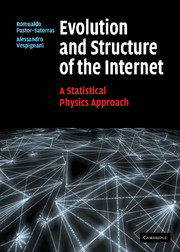Book contents
- Frontmatter
- Contents
- Preface
- List of abbreviations
- 1 A brief history of the Internet
- 2 How the Internet works
- 3 Measuring the global Internet
- 4 The Internet's large-scale topology
- 5 Modeling the Internet
- 6 Internet robustness
- 7 Virtual and social networks in the Internet
- 8 Searching and walking on the Internet
- 9 Epidemics in the Internet
- 10 Beyond the Internet's skeleton: traffic and global performance
- 11 Outlook
- Appendix 1 Graph theory applied to topology analysis
- Appendix 2 Interface resolution and router topology
- Appendix 3 Numerical analysis of heavy tailed distributions
- Appendix 4 Degree correlations
- Appendix 5 Scale-free networks: scaling relations
- Appendix 6 The SIR model of virus propagation
- References
- Index
Appendix 2 - Interface resolution and router topology
Published online by Cambridge University Press: 12 January 2010
- Frontmatter
- Contents
- Preface
- List of abbreviations
- 1 A brief history of the Internet
- 2 How the Internet works
- 3 Measuring the global Internet
- 4 The Internet's large-scale topology
- 5 Modeling the Internet
- 6 Internet robustness
- 7 Virtual and social networks in the Internet
- 8 Searching and walking on the Internet
- 9 Epidemics in the Internet
- 10 Beyond the Internet's skeleton: traffic and global performance
- 11 Outlook
- Appendix 1 Graph theory applied to topology analysis
- Appendix 2 Interface resolution and router topology
- Appendix 3 Numerical analysis of heavy tailed distributions
- Appendix 4 Degree correlations
- Appendix 5 Scale-free networks: scaling relations
- Appendix 6 The SIR model of virus propagation
- References
- Index
Summary
Routers have multiple interfaces, each one corresponding to a physical connection with another peering router. By definition, each interface is associated with a different IP address. As discussed in Chapter 3, path probing discovers router interfaces. In particular each probing path will record a single interface for each traversed router, generally the one from which the packet arrived to the router. It is therefore possible that probes coming from different monitors, even if directed to the same destination, might enter from different interfaces on the same intermediate router. Thus, each time a router is probed from a different perspective, its interfaces are registered as separate routers. A simple example of the difference between the physical router connectivity and the one registered by probing paths is depicted in Figure A1.1. In this example a network of four physical routers are connected through six different interfaces. The graphs resulting from path probes forwarded from opposite directions are different. By merging these different views, a graph with a false connectivity is obtained and the interfaces (router aliases) resolution becomes indispensable to reconstruct the physical router topology.
- Type
- Chapter
- Information
- Evolution and Structure of the InternetA Statistical Physics Approach, pp. 238 - 239Publisher: Cambridge University PressPrint publication year: 2004



